Shutter glasses as a training tool in tennis – influence of (image) frequency and dark phase ratio on eye-hand-(racket-)coordination
Purpose: The use of shutter glasses for perception training in sports requires knowledge of adequate load dosage. The study analyses the influence of (image-)frequency or “duty ratio” (dark phase percentage) on target stroke accuracy in tennis.
Material and Methods: With a total number of 22 tennis players (18m, 4f, mean age = 23.6, SD = ± 2.7 years) the target hit precision was conducted. The tennis players had to return the balls played to them by a ball machine using the forehand volley and to make direct hits to a bull´s eye (high scores = high target hit precision). The results with different (randomised) conditions (strobe rates level II = 5.3 Hz, level V = 2.3 Hz, level VIII = 1.0 Hz; dark phase level II = 88 ms, level V = 341 ms, level VIII = 909 ms) of currently used shutter glasses (Nike Vapor Strobe) and without occlusion have been compared.
Results: High level tennis players reached significantly better target hit precision scores without occlusion compared to lower level tennis players (81.2 ± 7.5 vs. 66.7 ± 18.1; T(17) = 2.634, 2p = 0.017). By increasing level (lower frequency and higher dark phase ratio) the target hit precision scores decreases significantly (without occlusion = 70.0 ± 17.3,
level II = 54.5 ± 15.9, level V = 41.7 ± 22.7, level VIII = 44.5 ± 24.3; F = 20.217, p = 0.000198). Analogously, the variability of the target stroke accuracy (coefficient of variation) increased (without occlusion = 24.8 %, level II = 29.1 %, level V = 54.4 %, level VIII = 54.7 %).
Conclusion: Lower frequency and higher duty ratio lead to increasing perceptual stress for the eye-hand-(racket-)coordination in a tennis specific situation. No discrete levels for changes in performance were found. Level V and VIII ensure a suprathreshold demand, where compensatory other resources have to be used to fill perceptual gaps and to be successful with respect to the target stroke accuracy. Stroboscopic visual training can thus at least potentially provide training stimuli to enable performance optimisation within the framework of individual adaptation reserves. Whether training with shutter glasses, developed/implemented on the basis of the study results, is then really effective must first be analysed in randomised, controlled training study.
Introduction
Athletes are often multi-discipline visual information managers.1,2,3,4 Good vision and perception as well as a high level of attention are indispensable for top athletes in training and competition. In tennis, for example, it is important to anticipate as accurately as possible which path the ball will take in order to hit it at the right moment at the right point in space.3,4,5
The quality of eye-hand-(racket-)coordination is indisputably one of the factors influencing performance and is dependent on good/optimal visual performance.4,5,6,7,8 It is also proven that the precision of eye-hand-(racket-)coordination can be trained.9,10
However, sports and sports science have so far hardly dealt with the possible optimisation of visual performance through systematic training. Currently, sports vision training is also offered in Germany and is already being used in some sports. Among other things, these trainings use components of visual training, supplemented by new training approaches/means geared towards the specific sport, including shutter glasses.10 With the help of these shutter glasses, perception can be specifically occluded in phases via frequency modulation and modification of the dark phase ratio.11,12 During stroboscopic training, tennis players must therefore perform eye-hand-(racket-)coordination on the basis of less (ball flight path) information (perception gaps) or correctly interpolate or extrapolate the ball flight path, which can only be perceived in phases (= temporal aspect when reading the ball flight curve).3,4
The reduction in perception achieved in this way could – as advertised by the manufacturers – serve as a training stimulus to optimise visual and sport-specific (perceptual) performance, for example to improve movement coordination (cf. also sensorimotor training). Several studies have already discussed effects and/or non-effects of stroboscopic training, for example in anticipation skills,13,14 movement perception and short-term memory.15,16 However, there have not yet been any truly scientific, randomised controlled studies that prove the effectiveness of the use of shutter glasses in sport. This is also due to the fact that there is no corresponding basis for the systematic design/implementation of stroboscopic visual training, for example, the optimal (image) frequency or the training load, etc.11,12,17
Against this background and based on a laboratory study in cooperation with the Ruhr University Bochum (Chair of Sports Medicine and Sports Nutrition) and the Ernst Abbe University of Applied Sciences in Jena (Department of SciTec),11,12 in which fundamental aspects of the influence of shutter glasses or the stroboscopic effect on visual performance, such as stereo/depth vision or motion perception, were investigated, the present field study analyses the influence of the use of shutter glasses with varying frequency/dark phase ratio on the precision of eye-hand-(racket-)coordination and target hit precision in tennis; the focus is therefore on the temporal aspect of interpreting the ball flight curve. This is operationalised by quantifying the target hit precision in forehand volley.
The following research questions can be derived from a synoptic view for the present study: To what extent is the target hit precision, and thus indirectly the precision of the eye-hand-(racket-)coordination, in forehand volley in tennis influenced/changed by varying the (image) frequencies and dark phase ratios? Can we detect discrete levels as thresholds for training recommendations, for example?
Material and methods
Sample
A total of 22 tennis players of different playing levels, 18 men and 4 women, aged 17 – 27 years (mean age: 23.6 ± 2.7 years) participated in the study.
The players completed an average of 2.0 (± 1.5) training sessions/week at the time of the test.
The study was approved by the ethics committee of the Faculty of Sports Science at the Ruhr University Bochum and was in accordance with the principles of the Declaration of Helsinki. Informed agreement was obtained from each subject before the start of the study.
According to the German Tennis Federation‘s (DTB) Performance Classification System (LKO), the players were categorised as top players/high level (cf. DTB ranking list
< 150 = LK 1 to DTB LK 2-5) and medium/low level (DTB LK 6-10 to LK 21-23 and lower).
In addition, the players subjectively rated their own
tennis-specific performance on a scale from 1 (amateur player) to 10 (professional player) with an average of 5.2 (± 1.8;
range = 2-8).
Shutter glasses of the type Nike Sparq Vapor Strobe (Nike, USA) were used for phase-wise stroboscopic occlusion of perception via frequency modulation and change of the dark phase ratio (Figure 1a and 1b).
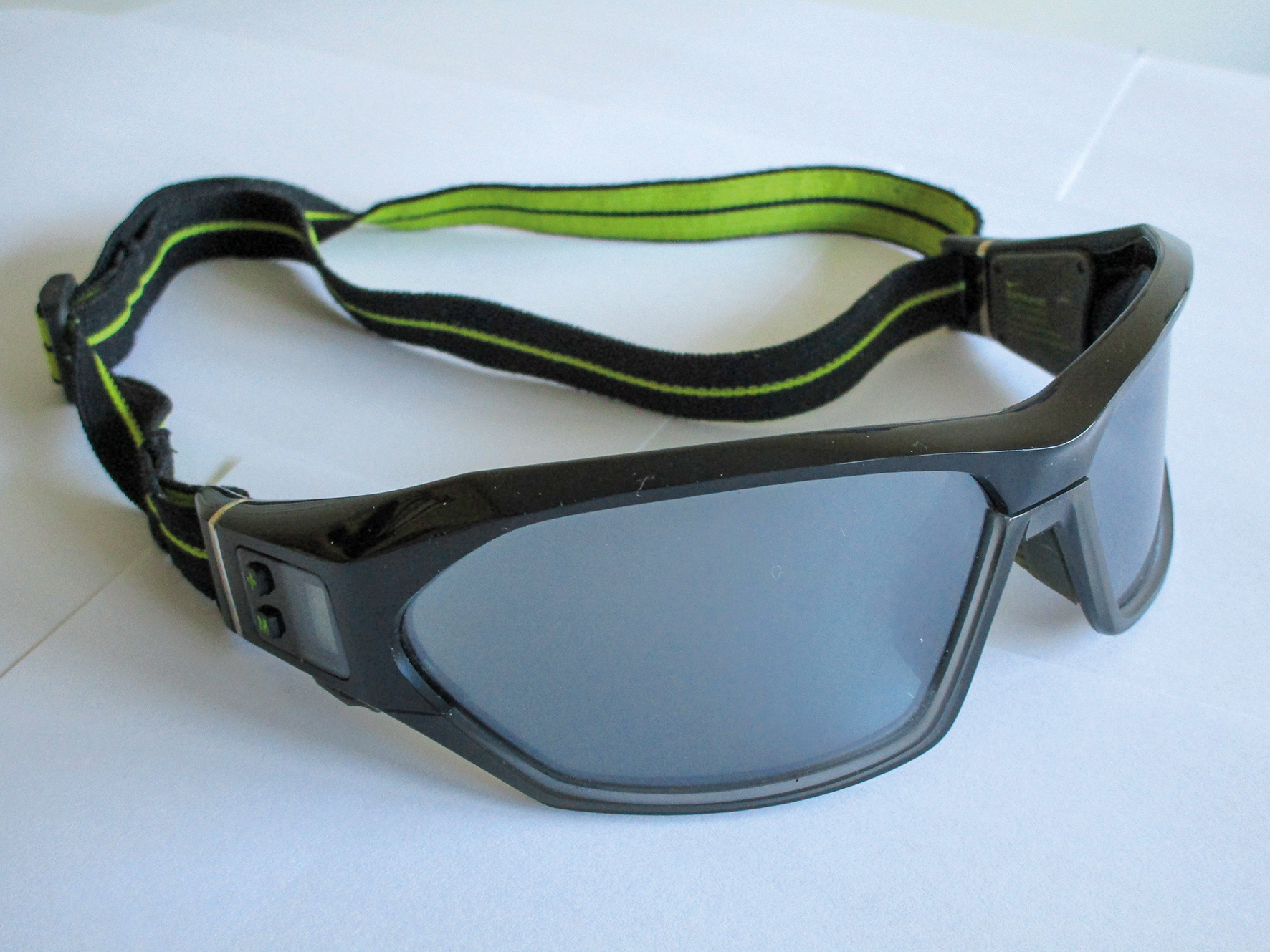
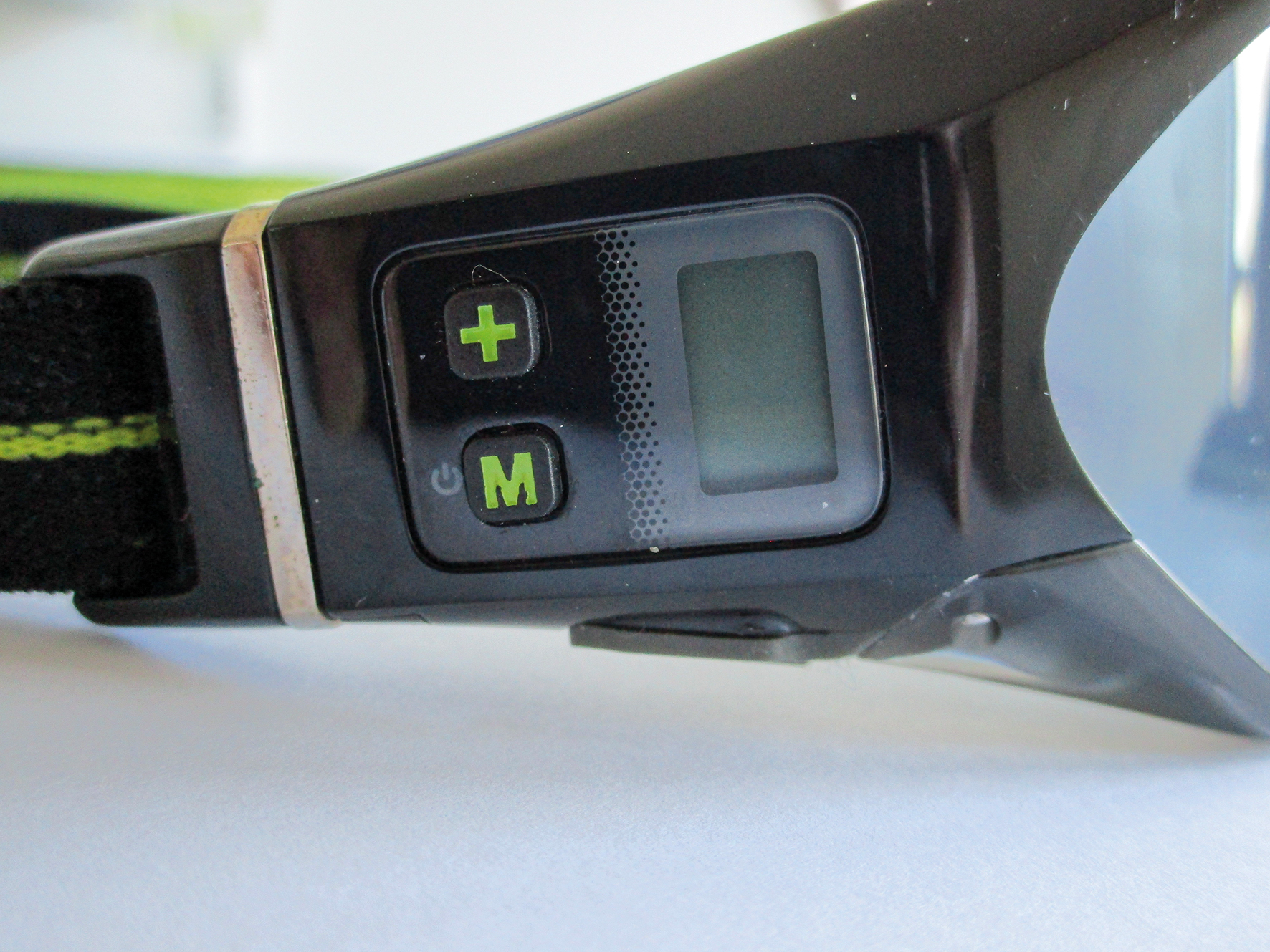
The Nike Vapor Strobe occludes from approx. 60 ms dark phase (level I) to approx. 900 ms dark phase (level VIII), depending on the (load) level set, while the light phase is a constant 100 ms (Table 1). From stage I to stage VIII, the image frequency decreases as the ratio of dark to light increases (Table 1). Based on the recommendations by Platz (2013), levels II, V and VIII were selected for the present study.11

Experimental procedure
During the field tests on the tennis court (sports facilities of the Ruhr University Bochum), the tennis players had the task of striking balls dispensed from a tennis ball machine
(Miha 1000 – 24 V, S² – Sportgeräte Stöckle, Aitrang) as accurately as possible onto a target with a central bull‘s eye in the opponent‘s court (Figure 2a and 2b).
The target was drawn on the sandy ground with natural chalk (dry marking) with a central bull‘s eye with a diameter of 60 cm (if hit = 6 points) and five further target zones/rings arranged concentrically around the bull‘s eye at 30 cm intervals. From the central bull‘s eye to the periphery, the number of points achievable decreases accordingly (Figure 2a and 2b).
The precision of target hit coordination was analysed in randomised order with three different shutter setting modes (level II, level V and level VIII) and without occlusion, i.e., with normal transmission without variation/change of frequency and dark phase ratio. The shutter frequency decreases from level II (5.3 Hz) to level V (2.3 Hz) to level VIII (1.0 Hz); the dark phase proportion increases analogously (level II = approx. 88 ms, level V = approx. 341 ms, level VIII = approx. 909 ms; [Table 1]). 25 forehand volleys were played per test run/level after a warm-up and tennis-specific practice phase. The precision of the hits was recorded as a score by two test raters. In the case of critical decisions or decisions that differed between the raters, a parallel video recording was used for post-analysis (Figure 2a and 2b). However, the deviation rate was low, also because the ball marks on the sandy floor (clay court) were clearly recognisable.
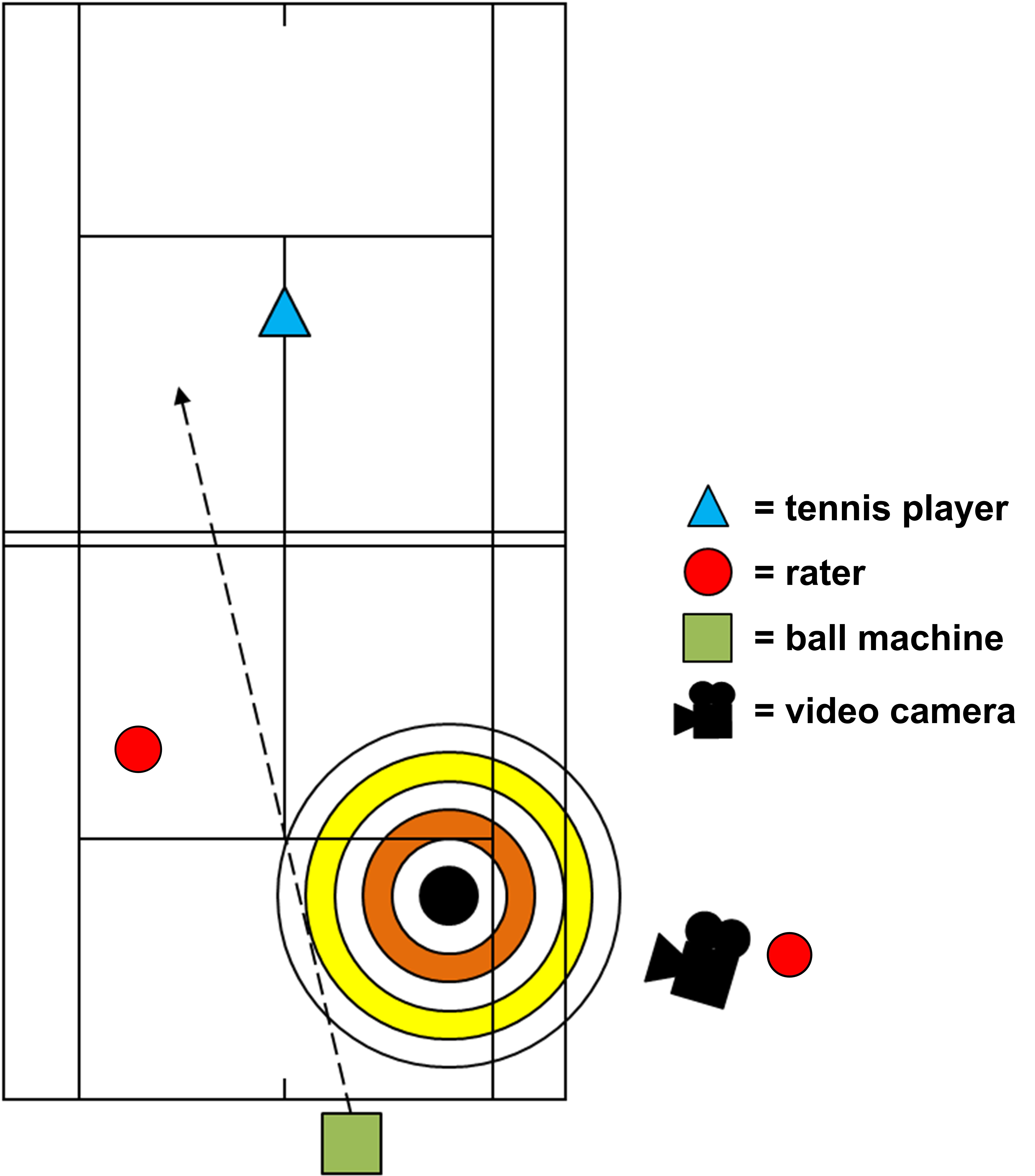
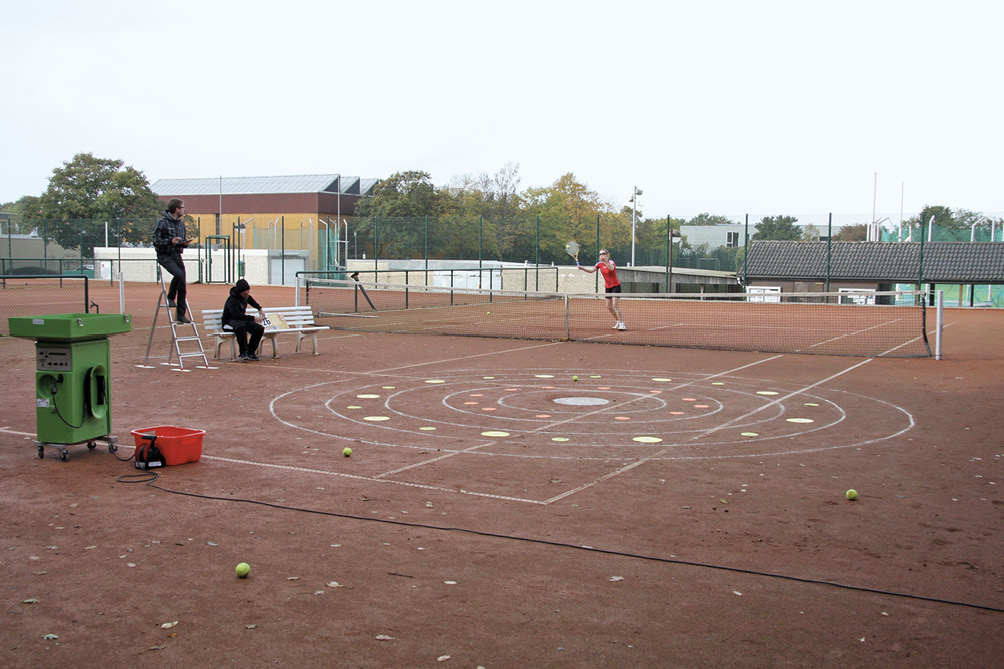
Furthermore, the subjectively perceived impairment of the sport-specific perception and playing performance due to the partial occlusion was surveyed with the help of an ad-hoc questionnaire (grade 1 = not impaired to grade 6 = very impaired).
Statistical analysis
Statistical analyses were performed using the Statistical Software Package IBM*SPSS* Statistics for Windows, Version 27.0 (IBM Corp., Armonk, NY, USA). The significance level was set at p ≤ 0.05.
First, the data (including the differences in repeated measures) were tested for normal distribution using the
Kolmogorov-Smirnov test including significance correction according to Lilliefors or the Shapiro-Wilk test. Subsequently, if the prerequisites were fulfilled, a one-factor variance analysis with repeated measures (ANOVA; dependent variable = target hit precision over 4 measurement levels) was first carried out in order to be able to detect possible differences in target hit precision with the different shutter glasses settings (in the case of non-parametric data or prerequisite violations, the Friedman test was used analogously). On the basis of the results of the variance analysis, pairwise comparisons were carried out using the t-test for dependent samples (for non-normally distributed variables, the Wilcoxon test was used where appropriate). Due to the multiple application of the t-test on one sample, an alpha adjustment, i.e., a Bonferroni correction, was carried out.
Using a two-factor variance analysis with repeated
measures, interactions between the subpopulations (factor group, independent variable = performance level classes divided into top players/high playing level and middle/lower playing level or median halved according to performance level) and the four consecutive measurement points (factor time = dependent variable) were calculated for all target parameters.
Correlations were calculated using Pearson‘s correlation coefficient and Spearman‘s rank correlation coefficient (Spearman-Rho).
Descriptive statistics included the calculation of mean values ± standard deviations for normally distributed
variables and the determination of the median ± quartile distances for non-normally distributed variables and non-parametric data.
The graphical representation was done with the programme Grapher 8.0 (Golden Software Inc., Colorado, USA).
Results
The results show that the quality of target hit precision significantly decreases by about 33 % from a mean of 70.0 ± 17.3 points to a mean of 46.9 ± 18.5 points due to phasic stroboscopic occlusion of perception across all levels (levels II, V and VIII) compared to no occlusion (n = 22; T(21) = 6.564, 2p = 0.000002).
A variance analysis of the change in target hit precision over the course of the measurement in relation to the total sample (n = 22) shows that target accuracy is highest without occlusion at 70.0 ± 17.3 points and then decreases significantly with decreasing image frequency and prolonged dark/occlusion phases (level II = 54.5 ± 15.9 points, level V =
41.7 ± 22.7 points, level VIII = 44.5 ± 24.3 points; F = 20.217,
p = 0.000198 [Figure 3]).

The achieved scores in the measurements with perceptual reduction by means of the shutter glasses (level II, V and VIII) are significant in individual testing when compared to the scores obtained without occlusion in each case (without occlusion vs. level II [T(21) = 5.811, 2p = 0.000009]; without occlusion vs. level V [T(21) = 6.466, 2p = 0.000002]; without occlusion vs. level VIII [T(21) = 5.011, 2p = 0.000058]). From level II to level V, the hit precision also decreases significantly (T(21) = 3.390, 2p = 0.002765). Only between level II and level VIII (T(21) = 2.135, 2p = 0.044747) as well as level V and level VIII (T(21) = -0.960, 2p = 0.348207) is there no significant difference in the achieved target hit precision after alpha adjustment.
Subjectively, too, an increasing performance limitation is perceived between levels II, V and VIII due to the use of shutter glasses for forehand volley. The mean rating of the restriction on a scale of 1 (not impaired) to 6 (very impaired) worsens significantly from 3.3 ± 1.1 at level II, to 4.3 ± 0.9 at level V to 4.5 ± 1.3 at level VIII (chi-square (2) = 9.787, p = 0.0075; cf. Figure 4).
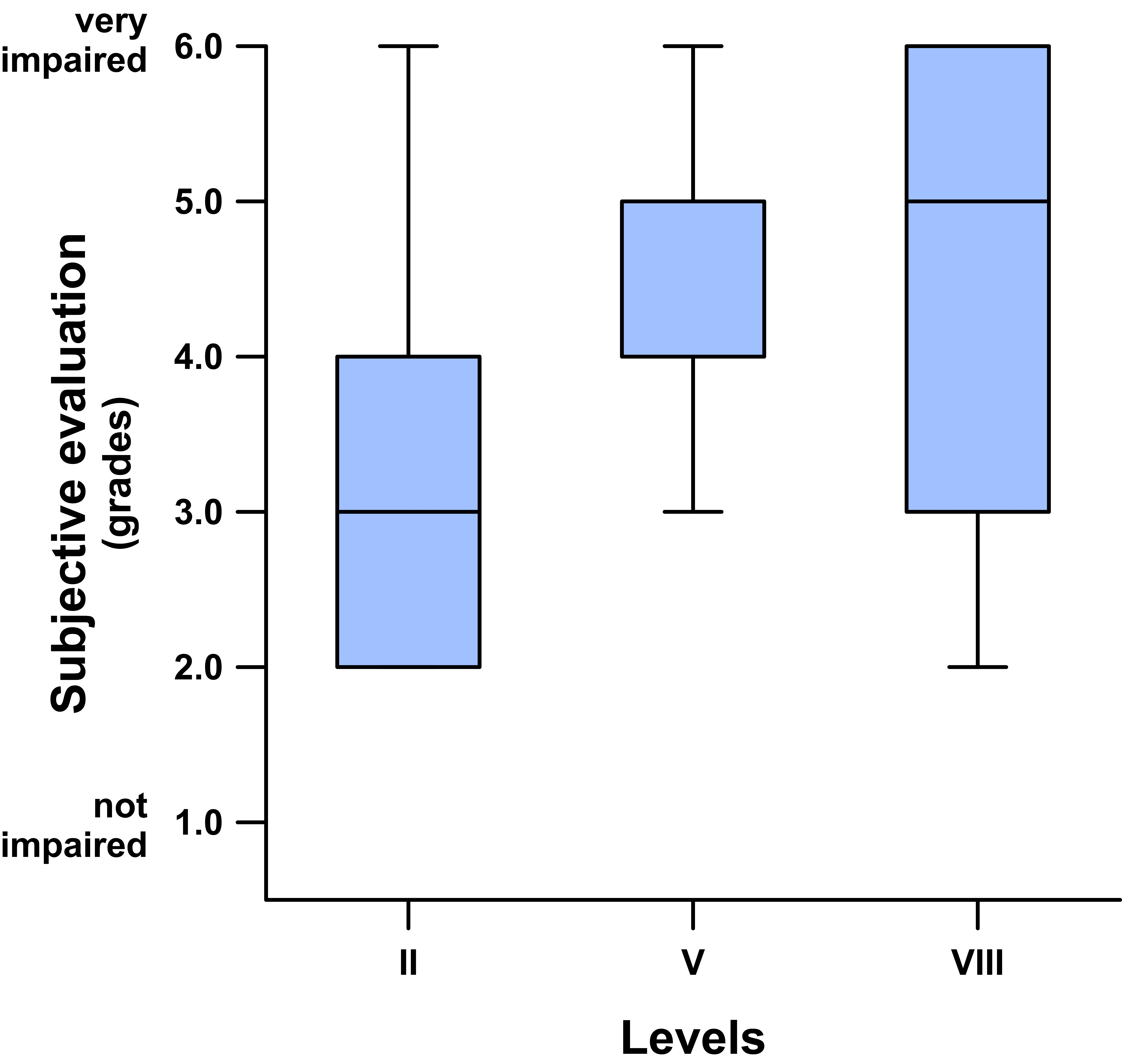
Figure 5 shows the hit-point variability, here calculated as a coefficient of variation; this increases significantly in the measurements with shutter glasses (level II, V and VIII) compared to without occlusion (without occlusion = 24.8 %, level II = 29.1 %, level V = 54.4 %, level VIII = 54.7 %;
cf. Figure 5).
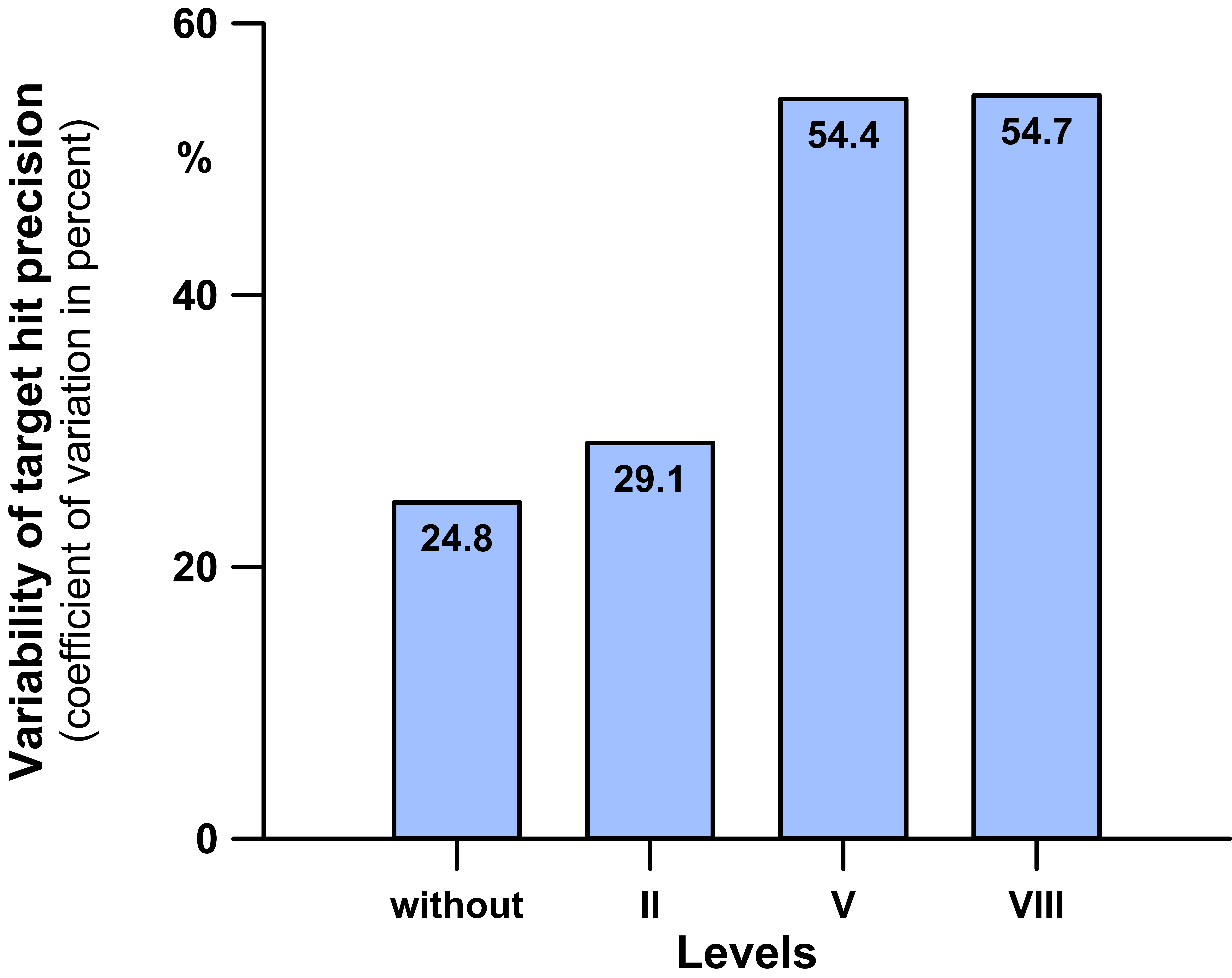
The correlation between the performance classification according to the DTB‘s performance classification system (LKO) and the subjective self-assessment of tennis-specific performance by the players themselves on a scale from 1 = amateur player to 10 = professional player initially results in a moderately strong to strong significant correlation of r = 0.59 (n = 22; 2p = 0.004; Spearman-Rho).
As expected, the target hit precision without occlusion of the top tennis players/players of higher playing levels is significantly higher (81.2 ± 7.5 points on average) than that of the players of middle and lower performance levels
[(66.7 ± 18.1 points); T(17) = 2.634, 2p = 0.017 (Figure 6)].
In a variance analysis of the change in target hit precision over the course of the measurement related to the comparison of top players (n = 5) vs. players of medium/low skill level
(n = 17), we could not determine any performance class-
related differences (i.e., related to the type or course of the decrease in performance) in the course of the measurement across the levels (F(1) = 0.115570, p = 0.737 [Figure 6]). The drop in precision with increasing/changing occlusion only occurs at a higher point level (higher overall precision,
Figure 6) for the top players.
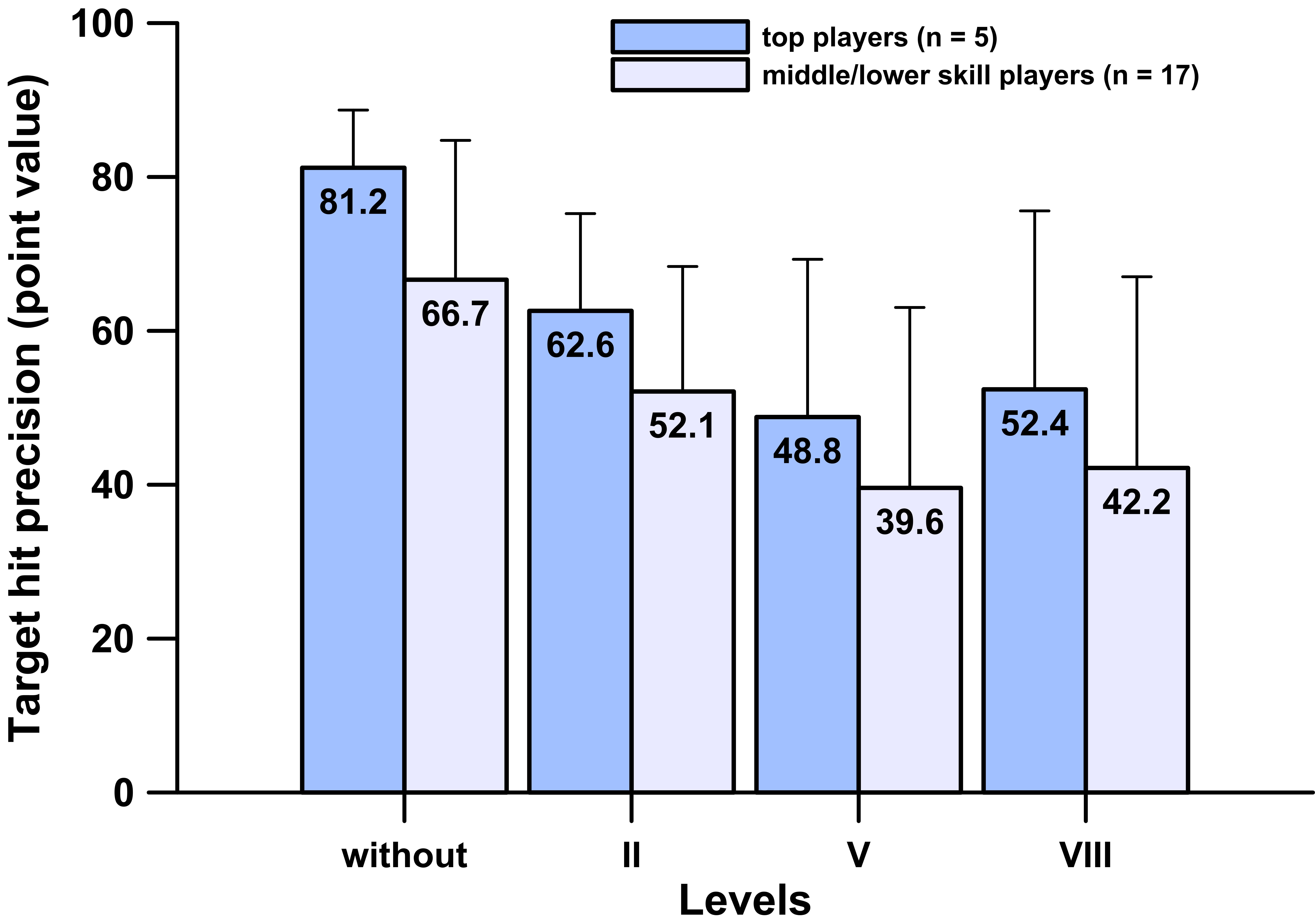
The hit-point variability (coefficient of variation) increases in the measurements with shutter glasses compared to without occlusion in the top players vs. players of medium/low level from 9.2 % vs. 27.2 % (without occlusion) to 20.2 % vs. 31.2 % (level II), 42.0 % vs. 59.2 % (level V) to 44.3 % vs. 58.9 % (level VIII).
If the total sample is divided into two equal groups according to playing ability, for example by bisecting the median, it becomes apparent that the change in precision over the course of the measurement (without occlusion, level II, V and VIII) is also independent of playing level (F(1) = 0.527, p = 0.476). However, the drop in performance with decreasing image frequency tends to be greater in the weaker group.
Discussion
An unsurprising result of the literature research and evaluation on the use and effectiveness of shutter glasses and stroboscopic training in the field of sports vision training is that a large number of the researched publications do not meet the usual scientific standards (for example, in an evaluation based on the recommendations for literature evaluation by the Cochrane Centre).
Although there are some —partly anecdotal— indications of the advantages of stroboscopic training 17,18 and various (sport-specific) case studies,19 there are only a few controlled, really scientific studies, for example RCT studies. Another problem is certainly that the manufacturers offer/sell the shutter or stroboscopic glasses without, at least so far, providing the corresponding instructions for use (training/test protocols, load standards) and without, at least to our knowledge, scientific proof of effectiveness.
A Bochum RCT study on the effectiveness of a sports-unspecific vision training 10,20 also for top athletes – which also included the use of shutter glasses – did not show any significant differences between the training group, which trained three times a week for six weeks, and the control group, which carried out an analogous placebo training. This is probably also because the training was very unsystematic/general and not requirement-related or (sport)-specific.10,20
Fundamental (also for the interpretation of the findings of the present study) are the results of Platz et al.,11,12 who were able to document that an increase in visual stress (also during training) seems to be possible with specific adjustment modes of the shutter glasses through occlusion, i.e. the partial removal of information, for example about the ball flight path.11,12
The authors were able to show, among other things, that the lower the image frequency and the higher the dark phase ratio (from level II to VIII [Nike Vapor Strobe, Nike, USA], Table 1), the more significant the limitations in the area of afferent motion perception and natural depth/stereo vision (between level II and VIII and level V and VIII). In addition, visual field expansion (for blue and especially red stimuli; between levels II and VIII and levels II and V) decreased significantly.11,12 Following the findings on training-induced neuronal plasticity, among others, stroboscopic vision training can thus at least potentially provide training stimuli to enable performance optimisation within the framework of individual adaptation reserves.
On the other hand, no significant deterioration could be observed in reaction and anticipation skills.11,12
The study presented here – which used levels II, V and VIII analogous to the recommendations of Platz et al.11,12 – was able to confirm the above results for the tennis-specific situation of a forehand volley at the net. The precision of the eye-hand-(racket-)coordination or the tennis-specific target hit precision decreased with increasing load (i.e., with lower image frequency and a higher dark phase ratio). Discrete levels could not be determined as limit settings.
Here, too, the clear, significant reductions in target hit precision, especially at levels V and VIII (cf. Figure 3 but also Figure 4: Subjective evaluation), showed that these levels (with occlusion times > 200 ms or image frequencies < 4 Hz [cf. Table 1]) are sensibly selected, since under these conditions the perception of apparent movements is no longer possible and movement perception is impaired (cf. overview in Platz, 2013, pp. 20, 21).11 Platz‘s laboratory results could thus be reproduced in a sport-specific situation: in this case the forehand volley in tennis.
With regard to the use of shutter glasses in training, a suprathreshold requirement as a training stimulus is achieved for the athlete at levels V and VIII; they must use other compensatory resources to fill the gaps in perception and to be successful in terms of the target hit. Consequently, a training success is at least conceivable through hyper-compensation mechanisms within the framework of the possibly existing individual adaptation reserves.
On the basis of the studies by Platz 11,12 and the present study, training with shutter glasses (using tennis as an example) can now be planned/structured and then evaluated in terms of effects. Whether stroboscopic training with shutter glasses can really achieve possibly also sustainable effects still has to be investigated in randomised, controlled training studies.
With regard to the hit-point variability, it should be noted that, on the one hand, it increases significantly in comparison without occlusion with decreasing image frequency and increasing dark phase ratio, and on the other hand, it is strongly dependent on the performance level. Even in the comparison without occlusion vs. level II, the top players showed significantly greater disturbances in the precision of eye-hand-(racket-)coordination; their sensory-motor reaction was significantly more susceptible to disturbances than that of lower-level players.
The laboratory findings of Platz et al.11,12 that stroboscopic
occlusion had no significant influence on reaction and anticipation ability could also be transferred to the results of the present study. Reaction and anticipation skills played only a subordinate role in the forehand volley test chosen here, since the direction of the ball flight (towards the forehand side) and the stroke technique (forehand volley) were predefined also by the ball machine. The correct reading of the ball flight path, as a prerequisite for hitting the ball at the right moment in the right point in space and placing it precisely is mainly fed by the perception of movement
and depth.
If necessary, situational differences related to the requirements must be taken into account when planning and designing training even within a specific sport. For example, in tennis, the objective (and possibly also subjective) time pressure (and thus the need to anticipate) is usually significantly higher in the volley at the net or service-return situation than in baseline play.
Conclusions
The study was able to prove that the target hit precision or the precision of the eye-hand-(racket-)coordination in tennis decreases with increasing load (i.e., lower image frequency and higher dark phase ratio). Discrete levels could not be determined as limit settings for training. Levels V and VIII ensure a suprathreshold demand where other resources have to be used to compensate and fill the gaps in perception and to be successful in terms of the target hit. Stroboscopic vision training can thus at least potentially provide training stimuli to enable performance optimisation within the framework of individual adaptation reserves.
This study thus provides the prerequisite for planning and structuring stroboscopic vision training with shutter glasses (using tennis as an example) and then carrying it out systematically over a longer period of time.
In view of such planning, it should be noted, in accordance with Tidow (1993, p. 66),1 „[…] that any visual training must be attributed a high degree of effect specificity and no generalisable transfer effects can be expected“. According to Munzert & Hossner (2008, p. 237),21 positive learning effects can only be expected „if the stimulus material in the training phase corresponds to the perceptual conditions in the real situation“. Elliott & Bennett (2021) 22 also describe that training/learning protocols in particular can be effective if they „challenge“ visual-motor processing in the context of a specific, visual-motor task, but do not change this task or change it only insignificantly 21 (i.e., comparable to the tennis-specific volley situation in the present study).
Although transfer effects from purely perceptual exercises to the real situation can be demonstrated in isolated cases, „in general, it can also be said for the coupling of perceptual and movement demands that they should be designed as specifically as possible, i.e., the training situation should correspond as closely as possible to the targeted game situation“. (Munzert & Hossner, 2008, p. 237).21
Consequently, further, especially sport-specific, research is necessary before an evidence-based use of shutter glasses as a training tool in sports can be asserted. Only then can the potential effects of systematic stroboscopic vision training be analysed more precisely in randomised, controlled training studies. Such an RCT training study is in preparation.
Conflict of interest
The authors declare that there is no conflict of interests regarding the methods and devices mentioned in the article.
COE Multiple Choice Questionnaire
The publication "Shutter glasses as a training tool in tennis – influence of (image) frequency and dark phase ratio on eye-hand-(racket-)coordination" has been approved as a COE continuing education article by the German Quality Association for Optometric Services (GOL). The deadline to answer the questions is 01,December 2024. Only one answer per question is correct. Successful completion requires answering four of the six questions.
You can take the continuing education exam while logged in.
Users who are not yet logged in can register for ocl-online free of charge here.
Koordination durch sensomotorische Übungsprogramme. In: BISp Jahrbuch 2001 (eds. Bundesinstitut für Sportwissenschaft), Köln, S. 113–126.
